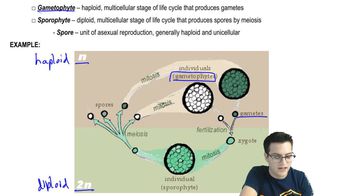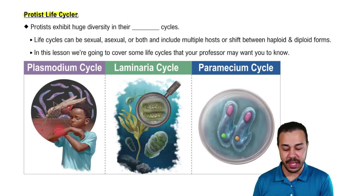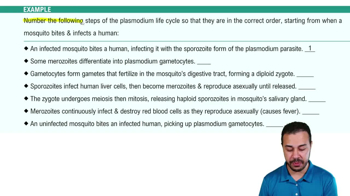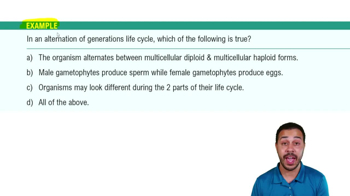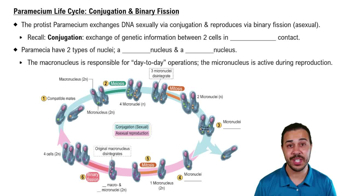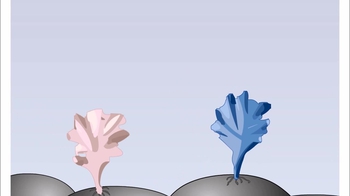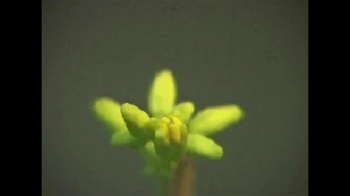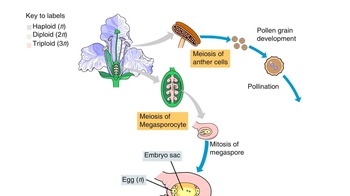Table of contents
- 1. Introduction to Biology2h 40m
- 2. Chemistry3h 40m
- 3. Water1h 26m
- 4. Biomolecules2h 23m
- 5. Cell Components2h 26m
- 6. The Membrane2h 31m
- 7. Energy and Metabolism2h 0m
- 8. Respiration2h 40m
- 9. Photosynthesis2h 49m
- 10. Cell Signaling59m
- 11. Cell Division2h 47m
- 12. Meiosis2h 0m
- 13. Mendelian Genetics4h 44m
- Introduction to Mendel's Experiments7m
- Genotype vs. Phenotype17m
- Punnett Squares13m
- Mendel's Experiments26m
- Mendel's Laws18m
- Monohybrid Crosses19m
- Test Crosses14m
- Dihybrid Crosses20m
- Punnett Square Probability26m
- Incomplete Dominance vs. Codominance20m
- Epistasis7m
- Non-Mendelian Genetics12m
- Pedigrees6m
- Autosomal Inheritance21m
- Sex-Linked Inheritance43m
- X-Inactivation9m
- 14. DNA Synthesis2h 27m
- 15. Gene Expression3h 20m
- 16. Regulation of Expression3h 31m
- Introduction to Regulation of Gene Expression13m
- Prokaryotic Gene Regulation via Operons27m
- The Lac Operon21m
- Glucose's Impact on Lac Operon25m
- The Trp Operon20m
- Review of the Lac Operon & Trp Operon11m
- Introduction to Eukaryotic Gene Regulation9m
- Eukaryotic Chromatin Modifications16m
- Eukaryotic Transcriptional Control22m
- Eukaryotic Post-Transcriptional Regulation28m
- Eukaryotic Post-Translational Regulation13m
- 17. Viruses37m
- 18. Biotechnology2h 58m
- 19. Genomics17m
- 20. Development1h 5m
- 21. Evolution3h 1m
- 22. Evolution of Populations3h 52m
- 23. Speciation1h 37m
- 24. History of Life on Earth2h 6m
- 25. Phylogeny2h 31m
- 26. Prokaryotes4h 59m
- 27. Protists1h 12m
- 28. Plants1h 22m
- 29. Fungi36m
- 30. Overview of Animals34m
- 31. Invertebrates1h 2m
- 32. Vertebrates50m
- 33. Plant Anatomy1h 3m
- 34. Vascular Plant Transport2m
- 35. Soil37m
- 36. Plant Reproduction47m
- 37. Plant Sensation and Response1h 9m
- 38. Animal Form and Function1h 19m
- 39. Digestive System10m
- 40. Circulatory System1h 57m
- 41. Immune System1h 12m
- 42. Osmoregulation and Excretion50m
- 43. Endocrine System4m
- 44. Animal Reproduction2m
- 45. Nervous System55m
- 46. Sensory Systems46m
- 47. Muscle Systems23m
- 48. Ecology3h 11m
- Introduction to Ecology20m
- Biogeography14m
- Earth's Climate Patterns50m
- Introduction to Terrestrial Biomes10m
- Terrestrial Biomes: Near Equator13m
- Terrestrial Biomes: Temperate Regions10m
- Terrestrial Biomes: Northern Regions15m
- Introduction to Aquatic Biomes27m
- Freshwater Aquatic Biomes14m
- Marine Aquatic Biomes13m
- 49. Animal Behavior28m
- 50. Population Ecology3h 41m
- Introduction to Population Ecology28m
- Population Sampling Methods23m
- Life History12m
- Population Demography17m
- Factors Limiting Population Growth14m
- Introduction to Population Growth Models22m
- Linear Population Growth6m
- Exponential Population Growth29m
- Logistic Population Growth32m
- r/K Selection10m
- The Human Population22m
- 51. Community Ecology2h 46m
- Introduction to Community Ecology2m
- Introduction to Community Interactions9m
- Community Interactions: Competition (-/-)38m
- Community Interactions: Exploitation (+/-)23m
- Community Interactions: Mutualism (+/+) & Commensalism (+/0)9m
- Community Structure35m
- Community Dynamics26m
- Geographic Impact on Communities21m
- 52. Ecosystems2h 36m
- 53. Conservation Biology24m
27. Protists
Protist Life Cycles
Multiple Choice
Which of these statements about the plasmodium, laminaria, and paramecium life cycles is correct?
A
Plasmodium requires 2 hosts, Laminaria requires 1 host, Paramecium does not require a host.
B
Plasmodium only replicates asexually, Laminaria only has unicellular gametophytes, Paramecium undergoes conjugation.
C
Plasmodium requires a vector (a mosquito), Laminaria may look different depending on which stage of its life cycle it’s in, Paramecium creates genetic variation during its asexual reproduction phase.
D
Plasmodium requires 2 hosts, Laminaria may look different at different stages of its life cycle, Paramecium produces new cells during its asexual phase.
 Verified step by step guidance
Verified step by step guidance1
Understand the life cycle of Plasmodium: Plasmodium is a parasitic protozoan that causes malaria. It requires two hosts to complete its life cycle: a mosquito (the vector) and a human. The mosquito is responsible for transmitting the parasite to humans.
Examine the life cycle of Laminaria: Laminaria is a type of brown algae that exhibits alternation of generations. This means it has both a multicellular diploid stage (sporophyte) and a multicellular haploid stage (gametophyte). These stages can look different from each other, which is a key characteristic of its life cycle.
Explore the life cycle of Paramecium: Paramecium is a unicellular ciliate protozoan that primarily reproduces asexually through binary fission. However, it can also undergo a sexual process called conjugation, which involves the exchange of genetic material between two paramecia, leading to genetic variation.
Analyze the given statements: The first statement about Plasmodium requiring two hosts is correct. The second statement about Laminaria looking different at different stages is also correct. The third statement about Paramecium producing new cells during its asexual phase is misleading because it does not create genetic variation during asexual reproduction; genetic variation occurs during conjugation.
Conclude with the correct answer: Based on the analysis, the correct statement is that Plasmodium requires two hosts, Laminaria may look different at different stages of its life cycle, and Paramecium undergoes conjugation to create genetic variation, not during its asexual phase.

 1:04m
1:04mWatch next
Master Protist Life Cycles with a bite sized video explanation from Jason Amores Sumpter
Start learningRelated Videos
Related Practice

